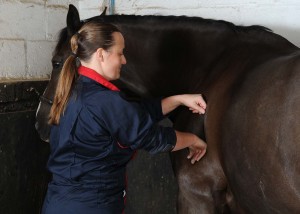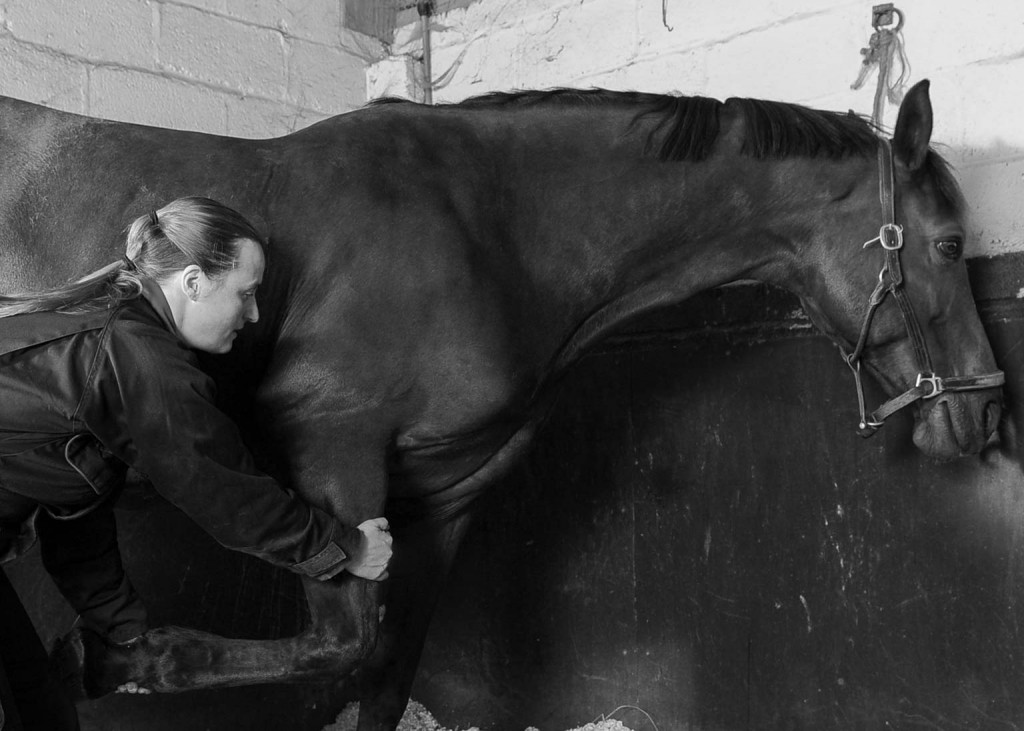Suzanne Crockford is a qualified equine sports massage therapist based around the borders of Hampshire, Berkshire and Surrey. She is available to treat horses across all three counties. Horse and Rider packages are also available.
Equine sports massage maintains and enhances muscle quality and performance, whilst improving joint mobility and range of movement. Additionally, it can help prevent serious injury by treating small muscle injuries that might not be immediately apparent, but which could otherwise carry the risk of further damage if untreated.
As an ESMA therapist I have a thorough anatomical understanding of the interrelation of muscles, joints and bone and will select and apply the appropriate techniques for each individual animal.
Benefits of Massage

Regular massage treatments can benefit your horse in a number of ways, including:
- Improving circulation
- Enhancing muscle tone and flexibility
- Relaxing muscles, improving lengthening and reducing muscle pain
- Preventing and relieving adhesion, restoring normal muscle function
- Increasing joint mobility and range of movement
- Aiding recovery and repair processes following strenuous activity or injury
- Improving the animals temperament
As well as the benefits already mentioned, regular massage promotes a healthy muscular skeletal system and aids detection of the early signs of tension or discomfort which, if left untreated, could cause altered gait patterns, muscle atrophy, pain or longer term damage. A regular massage routine can also help improve the temperament of your animal. Maintenance massage is particularly useful as a guide to what is normal for that particular horse and is recommended prior to booking a pre or post competition massage.

A pre-competition massage, carried out immediately before warm up, helps ensure the animal’s mental and physical well being and is key to preparing your horse for peak performance by:
- Calming and relaxing your horse, relieving tension and related pain
- Increasing oxygen and nutrient delivery and aiding waste removal to prepare the muscles for work
- Raising the temperature of muscles making them more pliable, increasing range of movement and preventing injury
- Stimulating the muscles following relaxation to prepare them ready for exercise
- Decreasing the time required in warm up. As the muscles are already warm and mobile, this can save vital energy for the main event.
- Identify cuts, wounds, grazes, and early signs of tension or inflammation,
- Prevent adhesions forming and realign the muscle fibres, restoring normal mobility and preventing future injury.
- Relieve areas of tension which can create altered movement patterns and stress other parts of the body as the horse tries to counteract pain or make up for loss of strength/power by overcompensating.
- Stretches and mobilises joint structures when the muscles have been warmed by massage, which maintains range of movement and prevents restricted joint movement.
For pre & post competition massage please call with details of event requirements for availability and prices.
Gift vouchers are available – please contact me for details.
Please note that cancellation of an appointment with less than 48 hours notice will incur a 50% charge, within 24 hours 100%.
In order to safeguard the welfare of animals, the veterinary act states that it is an offence for any person other than the owner of the animal to treat it without prior permission of the referred veterinary surgeon. As a fully qualified and insured equine sports massage therapist Suzanne will work with your vet and obtain the appropriate permission on your behalf prior to assessing or treating your animal.
Contraindications
Massage is not appropriate for your horse if it has any of the following conditions:
- Dehydration
- Tying up
- Skin disorders/infections
- Colic
- General or local infection
- Raised temperature/fever
- Open wounds (although massage around the area after the acute stage is recommended)
- Where active bone growth is possible or present
- Undiagnosed lameness, pain or illness
Please call or email for advice prior to treatment to discuss any such issues.
